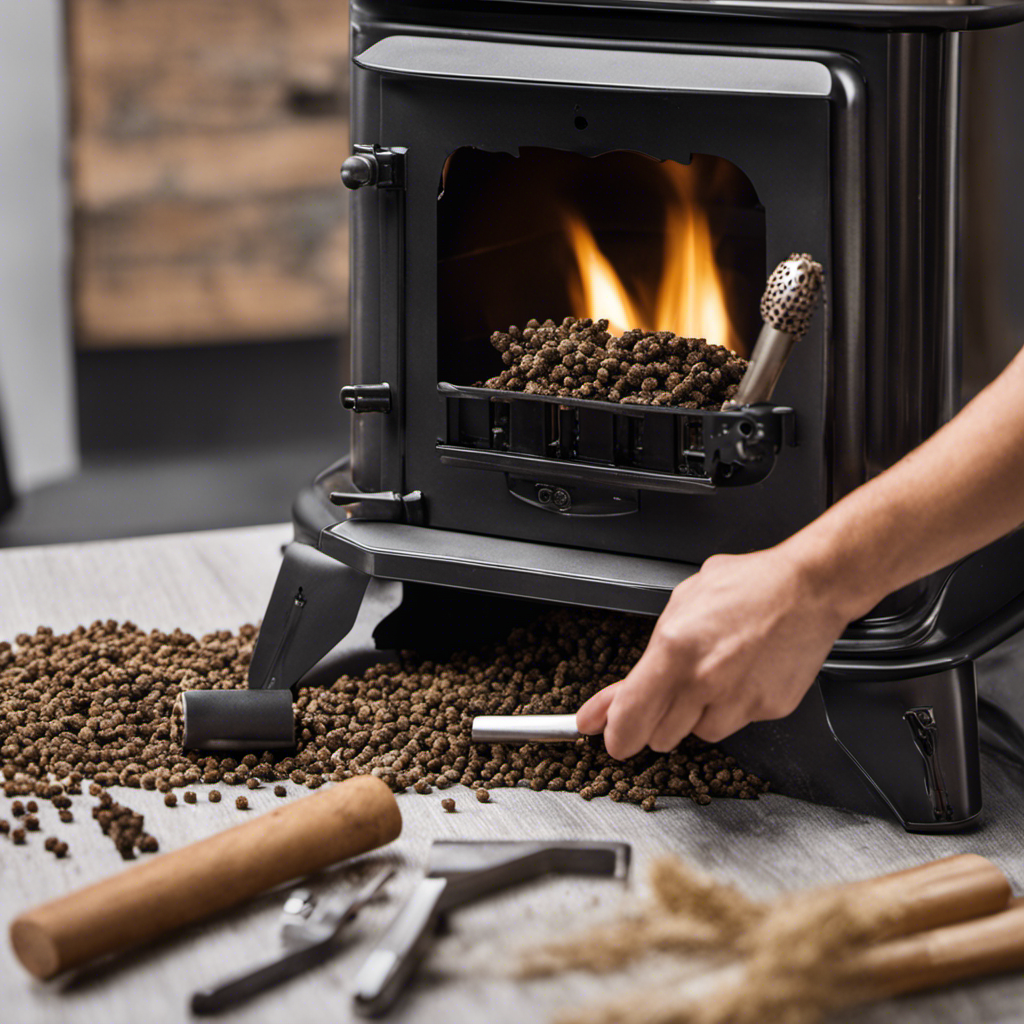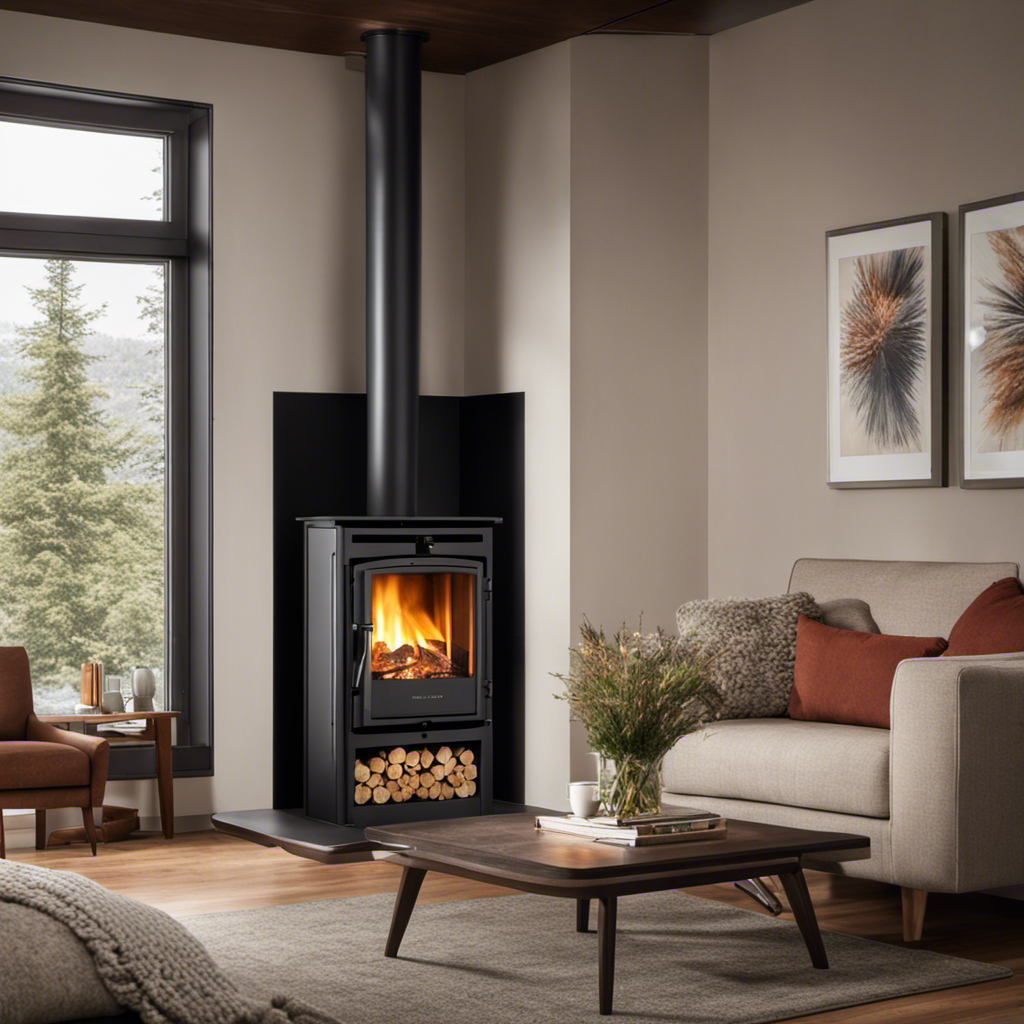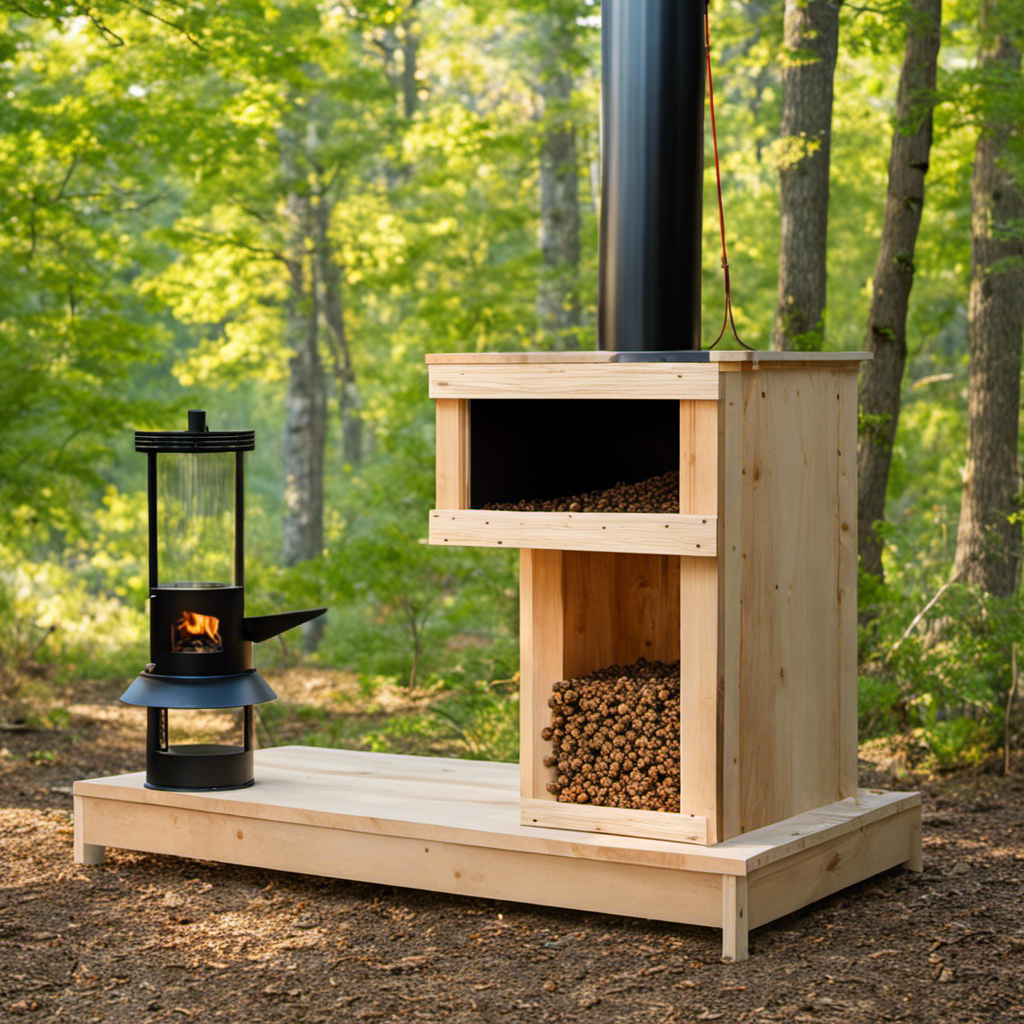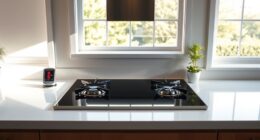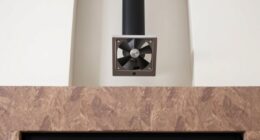This article demonstrates the proper method for maintaining your pellet stove, guaranteeing it operates at its best.
Maintaining a clean and well-maintained stove is crucial for its efficiency and longevity. By regularly cleaning the various components, such as the combustion chamber, burn pot, and ashtray, you can prevent clogs and improve airflow.
We’ll provide detailed instructions for cleaning each component, along with tips on how often to clean them.
With these cleaning practices, you can maximize the heating efficiency of your stove and enjoy a cozy home.
Key Takeaways
- Regularly clean the combustion chamber, burn pot, and ashtray to remove ashes and debris.
- Clean the fresh air inlet and exhaust vent to prevent blockages and ensure proper stove operation.
- Maintain the ignition system and control panel by removing debris and wiping surfaces regularly.
- Clean the glass door, heat exchanger, blower motor, pellet hopper, sensors, pellet chute, chimney flue, baffle plate, and auger to optimize stove performance and prevent malfunctions.
Cleaning the Combustion Chamber, Burn Pot, and Ashtray
When cleaning the combustion chamber, burn pot, and ashtray, we should turn off and cool down the pellet stove before removing ashes with a vacuum cleaner. This is an important step to ensure safety and prevent any potential accidents.
Once the stove is cool, we can use a stiff brush to loosen any stubborn debris in the combustion chamber and burn pot. It’s crucial to clean these areas regularly to maintain optimal stove performance. After loosening the debris, we can clean the surfaces with a damp cloth and mild detergent, making sure to dry them thoroughly before replacing the ashes.
Common cleaning mistakes include not turning off the stove or not allowing it to cool down properly before cleaning, which can lead to burns or other accidents. Additionally, using harsh chemicals or excessive moisture can damage the surfaces of the combustion chamber and burn pot, affecting their functionality.
It’s important to follow these cleaning techniques and avoid these common mistakes to keep the pellet stove in top condition.
Cleaning the Fresh Air Inlet and Exhaust Vent
To ensure proper stove operation, we need to regularly clean the fresh air inlet and exhaust vent. Preventing blockages and ensuring proper ventilation are essential for the efficient and safe functioning of a pellet stove. Neglecting to clean these components can lead to reduced performance, increased energy consumption, and even potential fire hazards.
Regularly inspecting the fresh air inlet and exhaust vent is crucial to identify any blockages or debris that may impede airflow. Cleaning can be done using a brush or vacuum attachment to remove any accumulated dust, dirt, or obstructions. By maintaining clear pathways for fresh air intake and exhaust, we can optimize the stove’s performance and prevent any potential issues caused by restricted airflow.
Incorporating a regular cleaning schedule for the fresh air inlet and exhaust vent is an essential part of pellet stove maintenance. By doing so, we can ensure that our stove operates efficiently, effectively, and safely.
| Fresh Air Inlet and Exhaust Vent Cleaning |
|---|
| – Regularly inspect for blockages or debris |
| – Use a brush or vacuum attachment to remove obstructions |
| – Ensure proper ventilation for stove safety |
| – Test stove operation after cleaning |
Cleaning the Ignition System and Control Panel
Regularly maintaining the ignition system and control panel is essential for ensuring the proper functioning and longevity of our pellet stove.
To clean the control panel buttons, start by turning off and unplugging the stove. Use a damp cloth to wipe down the panel, making sure to avoid using harsh chemicals or excessive moisture.
Cleaning the ashtray handle is also important. Remove the ashtray from the combustion chamber and use a stiff brush to remove any debris. Rinse it with warm, soapy water and dry it before replacing.
Cleaning the Glass Door
By regularly maintaining and cleaning the glass door, we can ensure that our pellet stove provides us with a clear view of the fire while keeping us warm.
To effectively clean the glass door, follow these steps:
- Choose the right cleaning products:
- Use a glass cleaner or a vinegar solution for effective cleaning.
- Avoid using abrasive materials or harsh chemicals to prevent scratches.
Preventing scratches:
- Use a soft cloth or paper towel to wipe the glass door.
- Avoid using abrasive materials that can scratch the surface.
Cleaning the Heat Exchanger and Blower Motor
When cleaning the heat exchanger and blower motor, we should first turn off and unplug the stove for safety.
The heat exchanger is responsible for transferring heat to the air, while the blower motor circulates air throughout the stove.
Regular cleaning of these components is essential for optimal performance and efficiency.
To clean the heat exchanger, remove the panels and use a vacuum or brush to remove any debris. If necessary, clean the surfaces with a damp cloth.
For the blower motor, turn off and unplug the stove, then remove the blower motor cover. Use a brush or vacuum to remove dust and debris.
These cleaning techniques will help maintain the functionality of the heat exchanger and blower motor, ensuring that your pellet stove operates smoothly.
Cleaning the Pellet Hopper and Control Panel
To maintain the functionality of the pellet hopper and control panel, we should regularly wipe down the control panel with a damp cloth and avoid using harsh chemicals or excessive moisture.
Cleaning techniques for the Pellet Hopper and Control Panel:
-
For the pellet hopper:
-
Empty any remaining pellets into a container.
-
Use a vacuum or brush to remove dust and debris.
-
Wipe down the hopper with a damp cloth.
-
For the control panel:
-
Turn off and unplug the stove.
-
Use a damp cloth to wipe down the panel.
-
Avoid using harsh chemicals or excessive moisture.
Maintenance tips for the Pellet Hopper and Control Panel:
- Clean the pellet hopper monthly to prevent clogs and malfunctions.
- Regularly clean the control panel to ensure proper stove function.
- Follow the manufacturer’s instructions for cleaning and maintenance.
- Monitor the hopper and control panel for any signs of damage or wear.
- Seek professional assistance if needed for any repairs or replacements.
Cleaning the Sensors and Electronic Control System
To ensure the efficient operation of our pellet stove, it is crucial to clean the sensors and electronic control system regularly. This will help maintain accurate readings and prevent any malfunctions. One important aspect is calibrating the temperature sensors to ensure they are providing accurate information. Additionally, it is essential to check for software updates and update the firmware for the control system if necessary. This will ensure that our stove is running on the latest software and taking advantage of any improvements or bug fixes. By cleaning and maintaining the sensors and electronic control system, we can ensure optimal performance and efficiency from our pellet stove.
| Calibrating Temperature Sensors | Updating Firmware for Control System |
|---|---|
| Ensure accuracy of readings | Stay up-to-date with latest software |
| Prevent malfunctions | Take advantage of improvements |
| Maintain optimal performance | Enhance stove performance |
Cleaning the Pellet Chute and Chimney Flue
Regular maintenance of the pellet chute and chimney flue ensures proper airflow and prevents blockages and obstructions. Cleaning the pellet chute is an essential part of pellet stove maintenance to ensure efficient pellet delivery. Neglecting this task can lead to reduced stove performance. Additionally, maintaining a clean chimney flue is crucial for the safe operation of the stove and preventing the buildup of dangerous creosote.
Here are some cleaning techniques for the pellet chute and chimney flue:
-
Pellet Chute Cleaning:
-
Remove any accumulated debris or unburned pellets from the chute.
-
Use a vacuum or brush to clean the chute thoroughly.
-
Wipe down the chute with a damp cloth to remove any remaining residue.
-
Chimney Flue Cleaning:
-
Inspect the flue for any blockages or obstructions.
-
Remove any ash or debris from the flue.
-
Ensure proper airflow in the flue for efficient stove operation.
Regularly cleaning the pellet chute and chimney flue will help maintain optimal stove performance and ensure safe and efficient operation.
Cleaning the Baffle Plate
Now let’s move on to the next step in efficiently cleaning your pellet stove for optimal performance: cleaning the baffle plate.
The baffle plate plays a crucial role in reflecting heat back into the firebox, but it can become coated with soot and creosote over time, reducing its effectiveness.
To ensure the baffle plate is clean and functioning properly, follow these cleaning techniques and safety precautions.
First, turn off and cool down the pellet stove before starting the cleaning process.
Next, carefully remove the baffle plate from the firebox. Put on gloves and a dust mask for safety.
With a stiff brush, scrub the baffle plate to remove any soot and creosote buildup.
Rinse the baffle plate with water and ensure it’s completely dry before reinstalling it in the firebox.
By regularly cleaning the baffle plate, you can maintain optimal stove performance and prevent heated air from escaping.
Remember to always prioritize safety and follow the manufacturer’s instructions when cleaning your pellet stove.
Cleaning the Pellet Hopper and Auger
Let’s make sure we clean the pellet hopper and auger regularly to prevent clogging and maintain proper stove operation.
-
Cleaning Techniques:
-
Empty the hopper and remove any remaining pellets.
-
Use a vacuum or brush to remove dust and debris from the hopper.
-
Wipe down the hopper with a damp cloth to remove any residue.
-
Clean the auger by removing it from the stove and inspecting for any blockages.
-
Use a brush or cloth to clean the auger and remove any buildup.
-
Reassemble the hopper and auger and ensure proper alignment.
-
Troubleshooting Tips:
-
If the hopper or auger becomes clogged, check for any obstructions and remove them.
-
If the stove isn’t feeding pellets properly, clean the hopper and auger to ensure smooth operation.
-
Regularly inspect the hopper and auger for any signs of wear or damage and replace if necessary.
Other Cleaning & Maintenance
We should also check and maintain the electric motors, distribution blower, sensors, and electronic control system to ensure proper functioning of our pellet stove.
Cleaning the electrical components is crucial for maintaining optimal performance. We should inspect the electric motors regularly for any dirt or debris that may affect their efficiency. It’s important to clean them thoroughly and lubricate the moving parts if necessary.
The distribution blower, responsible for circulating the air throughout the stove, should also be cleaned and its blades replaced if damaged.
Additionally, we need to inspect the sensors, such as temperature and pressure sensors, to ensure their accuracy and proper functioning.
Frequently Asked Questions
How Often Should I Clean the Sensors and Electronic Control System of My Pellet Stove?
When it comes to cleaning the sensors and electronic control system of your pellet stove, it’s important to perform regular maintenance to ensure optimal performance.
We recommend checking the sensors for accuracy and calibrating them if necessary.
It’s also a good idea to monitor sensor readings regularly and check for software updates to keep your control system functioning properly.
Can I Use Any Type of Glass Cleaner to Clean the Glass Door of My Pellet Stove?
Yes, you can use an ammonia-based glass cleaner to clean the glass door of your pellet stove. However, it’s important to exercise caution and follow the manufacturer’s instructions.
Alternatively, you can also use a vinegar and water mixture to clean the glass door. Be sure to use a soft cloth or paper towel to wipe the glass and avoid using abrasive materials that may scratch the surface.
Regular cleaning of the glass door ensures a clear view of the fire and optimal stove performance.
Is It Necessary to Clean the Baffle Plate of My Pellet Stove? if So, How Often Should I Do It?
Yes, it’s necessary to clean the baffle plate of your pellet stove to maintain optimal performance.
The baffle plate reflects heat back into the firebox, but soot and creosote can reduce its effectiveness.
To clean it, remove the baffle plate from the firebox and scrub it with a stiff brush to remove soot and creosote.
Rinse it with water and dry it before reinstalling.
Aim to clean the baffle plate at least once a month to prevent heated air escape.
What Is the Best Method for Cleaning the Pellet Chute and Chimney Flue of a Pellet Stove?
To efficiently clean the pellet chute and chimney flue of a pellet stove, there are a few cleaning techniques that can be used.
First, we recommend removing any ash or debris from the exhaust system and checking for blockages or obstructions in the exhaust pipe. It’s important to ensure proper airflow in the exhaust system to maintain optimal stove performance.
Additionally, monitoring the exhaust system for any signs of leaks or damage is crucial. Common maintenance mistakes include neglecting to clean the chute and flue regularly, which can lead to reduced stove performance.
How Often Should I Clean the Distribution Blower of My Pellet Stove and When Should I Replace the Blades?
When it comes to maintaining the distribution blower of our pellet stove, we should clean it regularly to ensure optimal performance. It’s recommended to clean the blower at least once a year or more frequently if we notice a decrease in airflow or unusual noises.
Signs that indicate the need for blade replacement include visible damage or wear, excessive vibration, or reduced airflow. Regular maintenance and prompt blade replacement will help keep our pellet stove running smoothly.
Conclusion
So, now that you’ve completed the meticulous cleaning process of your pellet stove, you can sit back and enjoy the irony of it all.
As you bask in the warmth and efficiency of your stove, remember the countless hours spent scrubbing, vacuuming, and maintaining every nook and cranny.
The gleaming components and free-flowing airflow are a stark contrast to the soot and debris that once plagued your stove.
Embrace the irony of the effort put into creating a clean and pristine environment amidst the cozy chaos of a burning fire.
Logan’s affair with adventure began in childhood. He hailed from a small town where vast forests bordered one side and endless shores stretched on the other. His days were spent exploring uncharted woods, climbing tall trees, or listening to the tales of old sailors. This early immersion in a world brimming with stories and mysteries became the foundation of his passion for writing.

